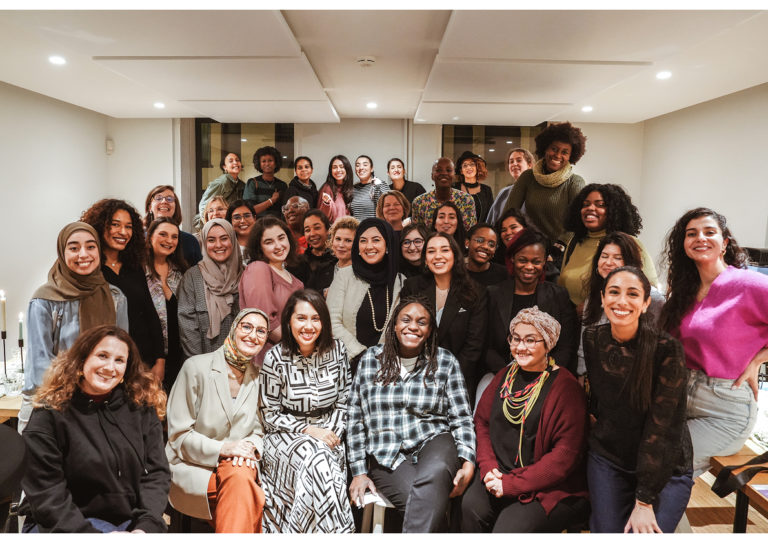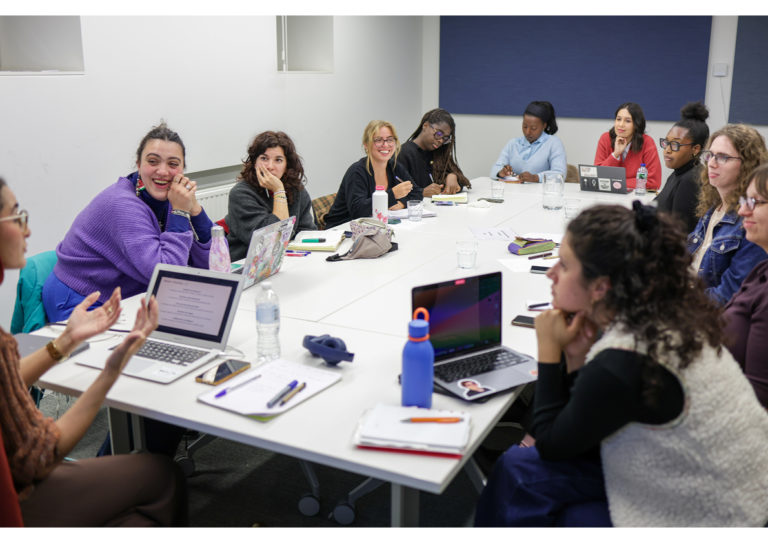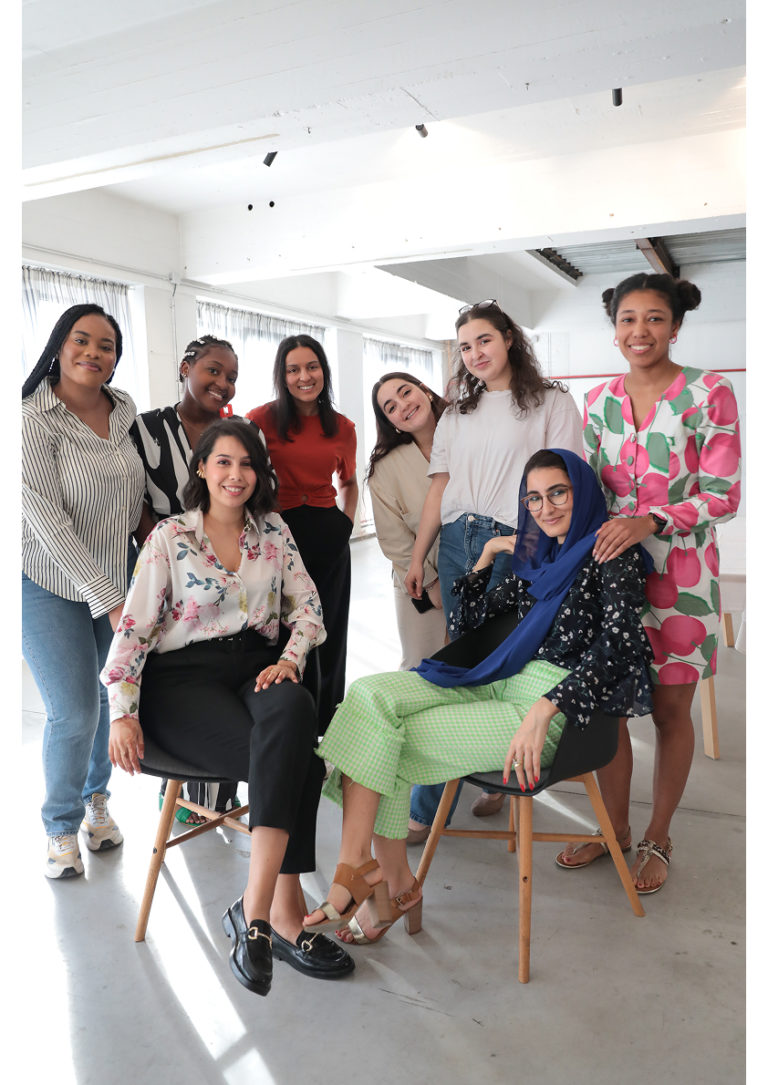This article is part of Reset! Yearly Focus 2025: Reclaiming Spaces
Author: Salwa Boujour
Belgium’s media landscape is at a crossroads. While the industry is constantly evolving under the pressure of digitalisation, precarious contracts, and shrinking editorial rooms, a quieter struggle unfolds behind the scenes: the fight of women journalists and media workers to simply exist in safe, dignified spaces.

Networking dinner 'Women in the Media', 2023 — © Hajar Machichi
The Safe Space initiative, launched by the Association for Diversity and Inclusion in the Media (ADIM), was born out of an investigation I led as journalist and ADIM co-founder.
In my 2019 master’s thesis at the Université Libre de Bruxelles, I documented how Belgian newsrooms can become spaces of interpersonal violence against women journalists.
What began as research quickly revealed a collective need: to transform silence into solidarity. Two years later, it has grown into a yearly gathering where participants can share experiences, build skills, and imagine alternative futures for the profession. In doing so, it reclaims a much-needed space in an industry where, according to a 2019 study published by the Association of Professional Journalists and Belgian Universities, in French-speaking Belgium, women make up only 35% of journalists (both accredited and trainees). That means nearly two thirds of Belgian journalists, those who shape national narratives, are still men. The imbalance affects not only newsroom culture, but also the stories and media representations.
One of our participants shared: “I stopped for several years because I lost interest in journalism. I was discouraged after graduating, and my first experiences proposing stories completely demoralised me.” The gap widens from the age of 30 onwards, and the number of women falls sharply after the age of 40. Above the age of 55, only 20% of journalists are women.
A Project Rooted in Urgency
The idea did not emerge in isolation. In 2020, as the Covid-19 pandemic exposed inequalities in every sector, Belgian media workers faced a double burden: newsroom cutbacks paired with an explosion of online harassment. A 2020 UNESCO report showed that 73% of women journalists who participated in the survey reported having experienced online violence. Belgium was no exception.
This chilling reality was vividly captured in the documentary #SalePute by Belgian journalists Myriam Leroy and Florence Hainaut, which exposed the daily torrent of insults, threats, and misogyny directed at women working in media and politics. The film’s impact helped break a national taboo around digital harassment, a topic often minimised as “part of the job.”
Florence Hainaut, who is now one of the coaches involved in our Safe Space programme, continues to channel that awareness into concrete empowerment tools for participants, helping them navigate online hostility without self-censorship.
Behind these numbers are countless silenced voices. Online abuse has become an invisible form of censorship pushing women to withdraw from the public sphere rather than risk another attack.
“How should I handle interactions with people who vent their feelings in comments? I dread a backlash if I have to tackle a subject alone,” asked a participant who attended the Safe Space for the first time in 2021.
This suffocation sparked action. I initially tested the Safe Space outside of the media world, but quickly repositioned itself within the sector. From 2022 onwards (after a year of testing the project), it was officially supported for three years by a government call for proposals launched by the Belgian Minister for Media, Bénédicte Linard, to tackle gender-based violence within the profession.

Safe Space workshop on personal branding: ‘How to create an image that opens doors’ with Bold Media Headlines, 4th edition, 2025 — © Salma El Gharbi
Evolving with its Participants
Each year, the Safe Space, built into 8 sessions, changes form to respond to both participants’ needs and the industry’s demands. Workshops on cybersecurity, leadership, and negotiation have been complemented with networking events, mentorship opportunities, and collective reflections on newsroom policies.
Journalist Sarra El Massaoudi joined ADIM as a project officer to co-coordinate the Safe Space initiative. She also created the podcast “Au cœur de la rédac” (Inside the Newsroom), a series dedicated to demystifying media practices and raising awareness about the inner workings and challenges of journalism.
Sarra El Massaoudi and I, both co-coordinators of the Safe Spaces, listen closely to what female media workers tell: sometimes they need tools for visibility, sometimes protection strategies, sometimes simply a space to share, listen, and exhale.
Crucially, the initiative fosters intergenerational encounters. Senior journalists share survival strategies and career lessons, while younger media workers bring fresh perspectives and digital skills. This dual movement transmission and discovery of talent ensures that experiences are neither lost nor siloed.
But beyond its evolving format, the Safe Space has also shifted in purpose from a confidential gathering to a political act of visibility.
The Safe Space experience concludes with the “Women in Media Networking Dinner,” a closing evening gathering women professionals, producers, and media workers to build connections beyond the programme and strengthen a wider network of women shaping the media landscape.
Making Invisible Struggles Visible
The Safe Space is not only a shelter; it is a stage. Participants are invited to speak publicly about their experiences, challenging a media culture where silence has long prevailed.
“The safe space gave me tools that I can use in the future (starting now). I'm thinking about how to negotiate and stand up for myself a little more, rather than adapting to the needs of publishers. I've learned how other women experience specific situations that I may not be experiencing myself, and how to support them when these situations arise,” declares a former participant after completing the Safe Space programme.
The testimonies collected serve as a living archive of gendered inequalities in Belgian media. We published a first intersectional report in 2021, making space for topics such as racism and validism. It highlights not only overt harassment, but also structural discrimination: women are less likely to be assigned to politics or economy beats as they are usually accused of being subjective and “activist,” more likely to be pushed towards lifestyle sections, and face pay gaps averaging. Our fellows testify: “I would like to be paid what I am worth. When I bring this up, my superiors agree that I am underpaid but do nothing to change it, even when they have the means to do so.”
While often described as “therapeutic,” ADIM emphasise that the Safe Space is first and foremost a tool for professional empowerment. Sessions on money and administration, creating a media, or personal branding allow participants to leave with practical skills. At the same time, the collective format encourages solidarity.
“The Safe Space helped me at a time when I really needed to find a space where I felt understood and legitimate. It was necessary: having a place where women of colour working in the media can exchange ideas, share experiences and support each other makes all the difference. I found strength, support and, above all, proof that I was not alone in this environment.”, says Julia Gligli, podcast creator and social editor for RTBF.

Reflective Safe Space meeting on ‘What future for women journalists in the media’ with presenter Salima Belabbas, 2023 — © Maryam Dahnin
Impact on the Media Landscape
The initiative also addresses the wider industry. Demonstrating the existence and voices of women journalists forces media organisations to acknowledge their responsibility in the lack of inclusion. In this sense, it echoes the work of collectives like Prenons la Une (France), or Women in Journalism (UK) that have campaigned for equal representation and safer working conditions for women in journalism.
For many participants, the Safe Space has served as a springboard: contacts made during the sessions opened doors to new collaborations, and younger freelancers have found mentors who helped them navigate precarious careers.
The ripple effects go beyond individual trajectories. The programme contributes to reframing the
Belgian media landscape itself, where diversity remains an unfinished promise. In March, the Reuters Institute, in partnership with the University of Oxford, published its 2025 report examining the gender distribution among leaders of 240 news organisations in 12 global markets. The study shows that women hold only 27% of editorial leadership positions.
Reclaiming Media Spaces
As cultural participation shrinks in a fragmented world, grassroots initiatives like the Safe Space show how reclaiming spaces can reshape entire fields. They are not parallel structures to mainstream media, but catalysts of change within it.
It’s a necessity for journalism itself. If half the population is excluded, our media will never be credible nor democratic.
By creating room for dialogue, skills, and solidarity, the Safe Space does more than protecting, it equips. It ensures that women journalists, from interns to veterans, can continue to claim their rightful place in shaping public discourse.
And in times when polyvalence is demanded but protection is scarce, these spaces might just be the only way for journalism to survive as a profession worth choosing.
Published on October 28th, 2025
About the author:
Salwa Boujour is a Belgian journalist, author, and founder of the Association for Diversity & Inclusion in Media (ADIM). Her work focuses on representation, equity, and the power of storytelling to drive social change. Through her writing, training, and public speaking, she commits to more inclusive and plural voices across European media.